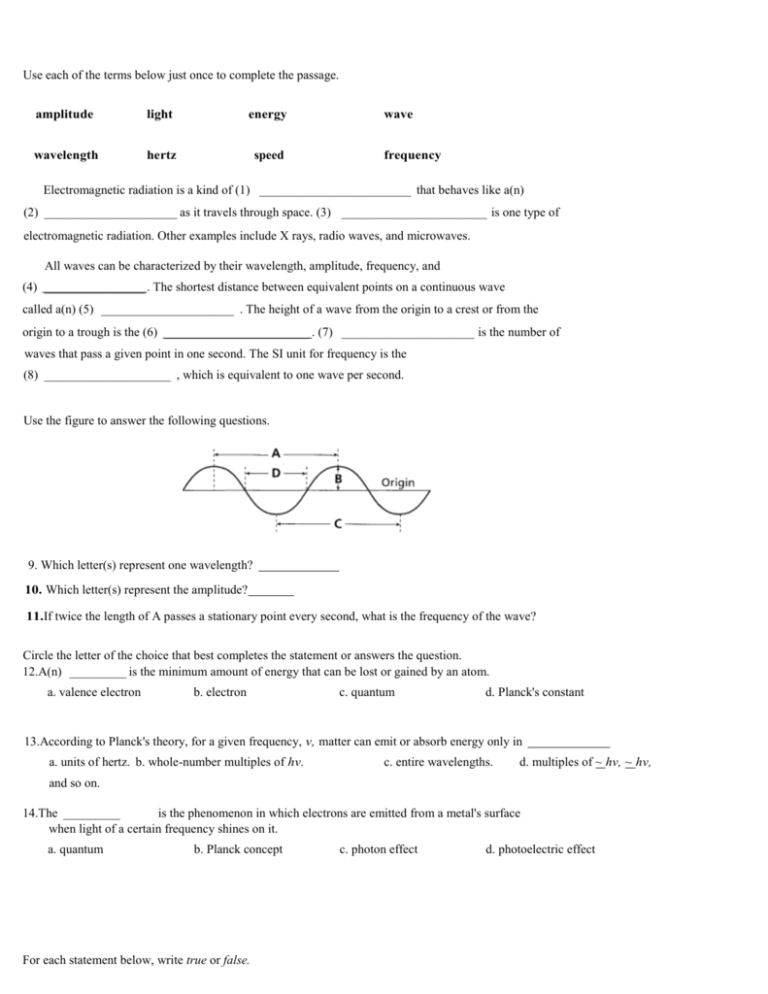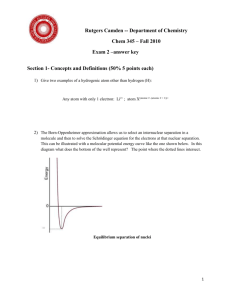CH 4 worksheet - study guide electrons
advertisement

Use each of the terms below just once to complete the passage. amplitude light energy wavelength hertz speed wave frequency Electromagnetic radiation is a kind of (1) ________________________ that behaves like a(n) (2) _____________________ as it travels through space. (3) _______________________ is one type of electromagnetic radiation. Other examples include X rays, radio waves, and microwaves. All waves can be characterized by their wavelength, amplitude, frequency, and (4) ________________ . The shortest distance between equivalent points on a continuous wave called a(n) (5) _____________________ . The height of a wave from the origin to a crest or from the origin to a trough is the (6) _______________________ . (7) _____________________ is the number of waves that pass a given point in one second. The SI unit for frequency is the (8) ____________________ , which is equivalent to one wave per second. Use the figure to answer the following questions. 9. Which letter(s) represent one wavelength? 10. Which letter(s) represent the amplitude? 11.If twice the length of A passes a stationary point every second, what is the frequency of the wave? Circle the letter of the choice that best completes the statement or answers the question. 12.A(n) _________ is the minimum amount of energy that can be lost or gained by an atom. a. valence electron b. electron c. quantum d. Planck's constant 13.According to Planck's theory, for a given frequency, v, matter can emit or absorb energy only in a. units of hertz. b. whole-number multiples of hv. c. entire wavelengths. d. multiples of ~ hv, ~ hv, and so on. 14.The _________ is the phenomenon in which electrons are emitted from a metal's surface when light of a certain frequency shines on it. a. quantum b. Planck concept For each statement below, write true or false. c. photon effect d. photoelectric effect 15.Like the visible spectrum, an atomic emission spectrum is a continuous range of colors. 16. Each element has a unique atomic emission spectrum. 17.A flame test can be used to identify the presence of certain elements in a compound . 18.The fact that only certain colors appear in an element's atomic emission spectrum indicates that only certain frequencies of light are emitted . 19. Atomic emission spectra can be explained by the wave model of light . 20.The neon atoms in a neon sign emit their characteristic color of light as they absorb energy. 22.When an atom emits light, photons having certain specific energies are being emitted. Use each of the terms below to complete the statements. atomic emission spectrum higher electron energy levels frequencies lower ground state 1. The lowest allowable energy state of an atom is called its _____________________________ _ _ 2. Bohr's model of the atom predicted the __________________________________ of the lines in hydrogen's atomic emission spectrum. 3. According to Bohr's atomic model, the smaller an electron's orbit, the atom's energy level. 4. According to Bohr's atomic model, the larger an electron's orbit, the _____________ the atom's energy level. 5. Bohr proposed that when energy is added to a hydrogen atom, its _____________ moves to a higher-energy orbit. 6. According to Bohr's atomic model, the hydrogen atom emits a photon corresponding to the difference between the ________________ associated with the two orbits it transitions between. 7. Bohr's atomic model failed to explain the _______________________ of elements other than hydrogen. 7518;4;(21500,0);(0,0);(0,21479);(21500,21479) For each item in Column A, write the letter of the matching item in Column B. Column A Column B _ a. Heisenberg uncertainty principle 10. The modem model of the atom that treats electrons as waves ___ 11. States that it is impossible to know both the velocity and the position of a particle at the same time the probability of finding an electron b. Schrodinger wave equation c. quantum mechanical model of the atom 12 A three-dimensional region around the nucleus representing the probability of finding and electron ___ 13. Originally applied to the hydrogen atom, it led to the quantum mechanical model of thethe atom three-dimensional region around nucleus representing In the space at the left, write the term in parentheses that correctly completes the statement. _________15. Atomic orbitals (do, do not) have an exactly defined size. _________16. Each orbital may contain at most (two, four) electrons. d. atomic orbital ________ 17. All s orbitals are (spherically shaped, dumbbell shaped). _________ 18. A principal energy has (n, n2) energy sublevels. _________ 19. The maximum number of (electrons, orbitals) related to each principal energy level equals 2n2. _________20. There are (three, five) equal energy p orbitals. _________ 21. Hydrogen's principal energy level 2 consists of (2s and 3s, 2s and 2p) orbitals. _________ 22. Hydrogen's principal energy level 3 consists of (nine, three) orbitals.








